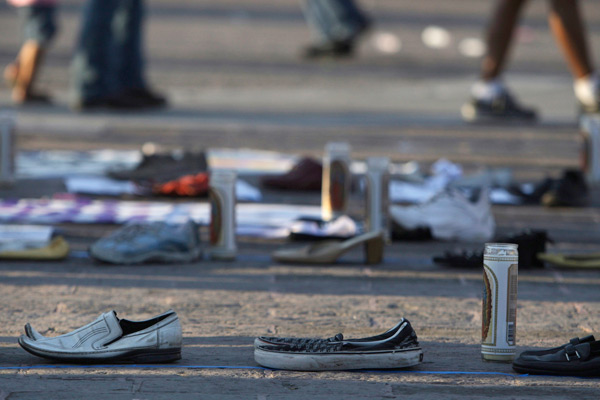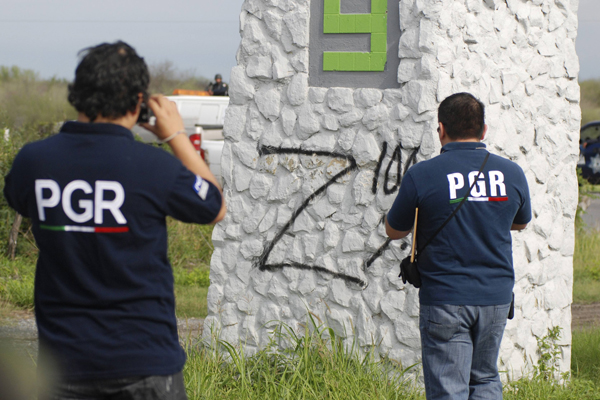
WASHINGTON (CNS) — In a country that has seen more than 50,000 deaths in six years, it took the finding of 49 headless bodies, some also missing arms or legs, to shock Mexican officials.
The discovery of the bodies, on a road about 120 miles from the United States, highlighted a problem addressed recently during a spring meeting at the World Bank headquarters in Washington.
Outgoing World Bank President Robert B. Zoellick warned that the violence doesn’t solely threaten Latin American citizens. It also poses a security threat to the United States, he said.
“The U.S. (needs) to take it seriously as a nation,” he said, addressing an audience gathered for a forum on “Reducing Murder Rates in Central America: Searching for Solutions.”
The meeting addressed Latin American countries with some of the highest rates of violence, including Honduras, El Salvador and Guatemala. But countries such as Mexico and other nations in South America are not exempt from the problem.
However, Zoellick pointed out that the dramatic numbers of homicides “for countries not at war” are in Central America.
Consider, he said, that Spain has roughly the same population as Central America.
In 2006, Spain registered 336 homicides, but Central America registered 14,257 homicides in the same time period — an average of 40 a day.
Gangs, the drug trade, and widespread and easy access to firearms — leftovers from civil wars — threaten people but also the development and future of the region, Zoellick said.
Even in a cloister, you can’t escape the effects of the violence, said Sister Mary Francis de la Cruz Montero.
Originally from Mexico, she lives in a monastery of the Capuchin Poor Clares in Pueblo, Colo. In a telephone interview with Catholic News Service, she described how her sister and her family were threatened in what started out as a common playground fight in a northern town in Mexico. Her nephew got into an argument with a boy at school and was told, “You’ll be sorry.”
Shortly after the fight, armed men showed up near his house. One of the boys in the family was beaten up. Sister Francis said all she could do was pray. She asked her family to report it to the police but a family in the neighborhood had disappeared after reporting a similar incident, her sister told her.
The armed men stayed in the neighborhood for more than a month and the family refused to go outside for fear of being killed, Sister Francis said.
“Sometimes the psychological damage is worse than death,” she told CNS.
In her ministry, she’s met migrants who have left Mexico, not because they can’t find work, but because of the violence, she added.
Milena Grillo, executive director of a Costa Rican nonprofit, made a presentation at the World Bank event and said the causes behind the numbers of rising violence are not solely drug related. They also can be attributed to interpersonal fights, such as the one described by Sister Francis, as well as to domestic violence and street crime, which is often solved by using firearms. The World Bank said “some 4.5 million small arms were in the region in 2007” and most were illegal.
Violence in Latin America can be prevented for a period of time by implementing a variety of programs, Grillo said, but such efforts often are disrupted with a change of political administrations.
Zoellick said something has to be done and soon.
“This is not just the role of the state or the Catholic Church,” he said, speaking of those trying to solve the problem. “The private sector has to say, ‘This is our problem, too.'”
Carlos M. Gutierrez served as commerce secretary for President George W. Bush and is now vice chairman of Citigroup’s Institutional Clients Group.
“When I was in business, the best region of the world was Latin America,” said Gutierrez, former Kellogg’s chairman and chief executive. “Those who decided to invest there are still there.”
But those who stayed pay a high cost to provide security for their businesses, he said. Other potential investors see that and are afraid of the region, he said.
The World Bank estimates the violence can cost up to 8 percent of Central America’s gross domestic product.
Even small-business owners, like Ines Chavarria, who lives in a Salvadoran suburb near the capital of El Salvador, said entrepreneurs are afraid of any ventures. Her husband used to drive a private school bus. But after being held up and threatened too many times, Chavarria decided the family would focus on baking and selling goods to other vendors. They don’t want to take the chance of handling money and being killed, she told CNS in a telephone interview.
Other small-business owners she knows decided to leave the country altogether, entered the United States illegally and set up business, even at the expense of having it taken away if they’re deported, she said.
Gutierrez, of Citigroup, hinted that mass deportation of Central Americans, especially if immigration reform doesn’t pass in the United States, would affect the lives of decent people and make matters worse.
“Imagine if we return people from Central America who are doing well here?” he asked.
It would have an economic cost to businesses but there would be other costs as well, he said.
“It would be a national security mess if we did that to Central America,” he said.
— By Rhina Guidos, Catholic News Service







